INTRODUCTION
Water is a prime natural resource, a basic human need and a preciousnational asset. Water as a resource is indivisible; rainfall, river waters, surfaceponds and lakes and ground water are part of a single unit, which needs aholistic and efficient management to ensure their long-term quality andavailability.
Agriculture is the main occupation of rural population in India. Irrigationhas played a pivotal role in India’s agricultural production and growth. Both atnational and regional levels, agricultural growth and overall development closelyfollow the growth pattern in irrigation. Investment in irrigation sector invariablyholds the key to open up the rural economy and provides impulse for overall ruraldevelopment. For sustenance and prosperity of human beings since long, thesewater resources played a key role in agricultural production through varioussystem of irrigation. Minor Irrigation (MI) system in India mainly used these waterresources in its natural form.
Minor Irrigation (MI) in India is defined as one with a command area of lessthan 2,000 hectares. There are mainly five types of MI structures that – dugwells, shallow tube wells, deep tube wells, surface lift systems, and surface flowsystems. Except the surface flow systems, all others are groundwater structures.Through the ages, these surface flow system or water bodies, either natural orman-made such as lakes, tanks, ponds and similar structures have sustained theIndian agriculture. A water body is a structure where water from ice-melt,streams, springs, rain or drainage of water from residential areas is accumulatedor water is stored by diversion from a stream, nala or river.
The traditional water bodies, known by their different names, such as Bhandaras (Maharashtra), phad irrigation (North-western Maharashtra), Khadin and Baolis (Rajasthan), Vav or Vavdi (Gujarat), Ahar Pynes (Bihar), Dung or Jumpois (Jalpaiguri district, WestBengal) and Zing (Ladakh, Jammu & Kashmir) have through the ages beenproviding sustenance to Indian agriculture and have their importance in theoverall development and management of water resources in the country. Water bodies are even religiously quite significant. Lakes of India, such as, Pushkar inRajasthan, Gurudongmar in Sikkim, and others are renowned for their religiousimportance. The striking beauty of lakes of India, like Vembanad Lake (Kerala),Bhimtal Lake (Uttarakhand), etc has made them favorite haunts for the tourists.
The lakes of Rajasthan add vigor to the colossal forts and palaces. Water Bodiesserve as storage reservoirs in the monsoon-dependent areas of the economywhere there exist a shorter period of rainfall and a long dry spell with very highdeviation of annual rainfall. The small storage tanks are called ponds or bundhiswhich are mostly community owned. The large storage tanks whose commandvaries from 20 to 2000 hectares are generally constructed by the governmentdepartments or local bodies.
Apart from irrigation, these tanks/ponds & lakes have traditionally playedan important role in drinking water supply, hydropower, ecology, tourism, cultureand other domestic uses. In 1950-51, the net irrigated area was 20.85 Mha andthe gross irrigated area was 22.60 Mha. An appreciation of the urgent need toharness this vital national wealth for increasing agricultural production meant thatthe national planning process accorded high importance and priority to developirrigation. The irrigation potential increased from 22.6 Mha in 1950-51 to about107.2 Mha upto 2010.
As per the 4th MI census (2006-07), over 5 lakh tanks, ponds and storagesin India were used for Minor Irrigation Schemes under surface flow and surfacelift creating an irrigation potential of about 5.89 Million ha. Out of these, about0.80 lakh water bodies were not in use causing a loss of 1.95 million hectareirrigation potential either due to under-utilization/ non-utilization. Out of this, 0.74lakh were temporarily not in use and about 0.24 lakh were permanently not inuse. Further, in the India-WRIS portal, total 798908 water bodies of area 0.01hectare area have been mapped which include both rural and urban areas. Eachof the water bodies have been assigned a unique identification number. Forwater bodies connected with large dams, attribute information is available. Thelist of the “State –Wise Statistics of Water bodies as per India-WRIS Project” isattached as Annexure-I.
India has a long history of human intervention in the management of waterfor agriculture, because of the country’s distinctive climate – intense monsoons followed by protracted droughts. The water harvesting structurescalled “tanks” (earthen bunded small storage reservoirs formed in the naturaldepressions of the land), indigenously designed by our ancient native rulersand chieftains over the past several centuries with the substantial storagecapacity. As the tanks are formed as chains akin to cascades, our tanksystem has proved to be superior because of the synergized hydrologicefficiency of the linkage between the tanks. As one of the still surviving,man-made and large common property resources of the society, theyconstitute a basic life support system in the most parts of India. Suchmarvelous and widespread life supporting traditional tank systems are gettingdeteriorated in the recent past due to poor maintenance and lack of interestamong the users.
Relative importance of some of these Water Bodies has waned due to anumber of reasons:
• Shifting away from community based tank system to individual beneficiary oriented ground water dependent system
• Prolonged and continuous neglect of maintenance
• Heavy silting of the tank bed,
• Choked up feeder channels,
• Leaking and weak bund, leaky sluices and dilapidated surplus weirs and ill maintained distribution channels
• Encroachments in the tank bund, foreshore, water-spread and supply channels
• Deforestation and denudation in the catchments areas leading to extinction of water bodies as a whole for housing and urbanization
• Indiscriminate use of tank beds as dumping yards
All these have also contributed to deterioration of the water bodies as a whole.
To revive, restore and rehabilitate the traditional water bodies, TheGovernment of India has launched a Scheme for Repair, Renovation andRestoration (RRR) of water bodies which has multiple objectives likeComprehensive improvement and restoration of water bodies thereby increasingtank storage capacity, Ground Water Recharge, Increased availability of drinkingwater, Improvement in agriculture/horticulture productivity, Improvement of catchment areas of tank commands, Environmental benefits through improvedwater use efficiency; by promotion of conjunctive use of surface and groundwater, Community participation and self-supporting system for sustainablemanagement for each water body, Capacity Building of communities, in betterwater management and Development of tourism, cultural activities, etc. byproviding Central Grant to State Governments under a Pilot Scheme directlylinked to agriculture during the remaining period of Xth Five Year Plan in January2005. It was visualized that this programme will go in a long way in enhancingwater availability in different parts of the country. For preservation and protectionof water bodies, Ministry of Urban Development (MoUD) has also issuedAdvisory which has been sent to all the State Governments for protection ofurban water bodies.
1. PILOT SCHEME: The scheme, in state sector, had an outlay of Rs. 300 crorewith 75% Central Assistance by Government of India and 25% by StateGovernment. The objective of the pilot scheme on water bodies was to restoreand augment storage capacities of water bodies and to recover and extendtheir lost irrigation potential. The water bodies having original irrigationculturable command of 40 hectare to 2000 hectare were eligible for fundingunder the pilot scheme. A total of 1098 water bodies in 26 districts of 15 stateswere taken up under Pilot Scheme for which central share of Rs. 197.30 crorewas released up to March, 2008. The work in respect of 1085 water bodieswas completed. Respective State Govts dropped remaining 13 water bodies.An irrigation potential of 0.78 lakh ha was restored under the Pilot Scheme.State-wise water bodies taken up, central assistance released and completedwater bodies under pilot scheme are enclosed at Annexure-II.
Independent evaluation of the Pilot Scheme was undertaken by variousorganizations, viz., Water Technology Centre for Eastern Region,Bhubaneswar, Water & Land Management & Training and Research Institute(WALAMTARI), Hyderabad; Centre for Water Resources Development andManagement (CWRDM), Kerala; Tamil Nadu Agricultural University,Coimbatore and National Remote Sensing Centre (NRSC), Hyderabad. Finalreports received from Water Technology Centre (WTC), Bhubaneswar andCentre for Water Resources Development & Management (CWRDM), Kerala;Water & Land Management & Training and Research Institute (WALAMTARI), Hyderabad; and National Remote Sensing Centre (NRSC), Hyderabad. Thesereports have shown that the scheme has resulted in many positive outcomeslike increase in storage capacity, increased utilization of water for irrigation,benefits of the scheme percolating to SC/ST families etc.
2. XI PLAN: Based on success of the pilot scheme, Two schemes of RRR, onewith domestic support with an outlay of Rs. 1250 crore and other with externalassistance with an outlay of Rs. 1500 crore were launched during XIth Plan.
The objectives of both the schemes covered mainly
a) Improvement of catchment areas of water bodies,
b) Command area development,
c) Increase in the capacity of the water body,
d) Ground water recharge,
e) Improvement in agriculture / horticulture productivity,
f) Development of tourism, cultural activities
g) Increased availability of drinking water.
i) Scheme with External Assistance: Under the scheme with loan assistancefrom the World Bank, GoI takes 25% of the World Bank loan and passes it tothe State Government as Central Assistance and 75% of the loan istransferred to the State Government on back to back basis to meet the Stateshare. Under this scheme, the States were allowed to take up the repair,renovation and restoration of water bodies having a minimum of 20 hectareoriginal irrigation culturable command area and upto a maximum of 2000hectare. The objectives of the scheme cover improvement of catchment areasof water bodies, command area development, increase in the capacity of thewater body, ground water recharge, improvement in agriculture / horticultureproductivity, development of tourism, cultural activities and increasedavailability of drinking water. The scheme was carried out with assistance fromWorld Bank. The appraisal process was coordinated by the Department ofEconomic Affairs.
The World Bank Loan Agreement was signed with Tamil Nadu for US $ 485Million to restore 5763 water bodies having a CCA of 4 lakh hectares. LoanAgreement with the World Bank was signed with Andhra Pradesh for US $ 189 Million for restoration of 3000 water bodies with a CCA of 2.5 lakh hectares.Loan agreement with the World Bank was signed with Karnataka forrestoration of 1224 water bodies having a CCA of 0.52 lakh hectare forassistance of Rs. 268.80 crore and with Odisha for US $ 112 million for 900water bodies with CCA of 1.2 lakh ha. Thus a total of 10887 water bodies havebeen taken for restoration under external assistance. The detail of waterbodies undertaken is enclosed at Annexure-III. The latest status of thescheme, as received from Department of Economic Affairs, Ministry of Financeis enclosed in Annexure-IV.
ii) Scheme with Domestic Support: Under the scheme of domestic support,Central assistance in the form of 90% of the cost of the project cleared by theTechnical Advisory Committee (TAC) of the State Government in case ofSpecial Category States, KBK (undivided) districts of Odisha and projectslocated in drought prone, tribal and naxal affected areas and 25% of cost ofthe Projects benefiting other areas of Non- Special Category States weregiven. A total of 3341 water bodies were taken up for restoration in 12 states.A total central grant amounting to Rs. 917.259 crore had been released to thestates for completion of works on these water bodies up to 31st March, 2015.Out of 3341, the works on 2222 water bodies have been completed and anirrigation potential of 1.133 lakh ha has been restored. Works on remaining1116 water bodies are undergoing. More information regarding completion ofthese water bodies is awaited from respective State Govts. To give impetus toearly completion of these water bodies, an amount of Rs 27.0 crore has beenreleased towards schemes of Odisha during 2014-15. However, no requestsfor release of fund have been received from other states for completion ofwater bodies undertaken during XI Plan. The scheme was monitored byCentral Ground Water Board (CGWB) and MoWR. The details of water bodieswith domestic support including grants released, completion, potential plannedetc is enclosed at Annexure-V.
3. XII PLAN: The scheme for Repair, Renovation & Restoration of Water Bodiescontinued during XII Plan and the scheme was approved by the UnionGovernment on 20.9.2013. Accordingly, Guidelines for the implementation ofthe scheme were issued in October, 2013.
The main objectives of the Scheme are:
(i) Comprehensive improvement and restoration of water bodies thereby increasing tank storage capacity
(ii) Ground Water Recharge
(iii) Increased availability of drinking water
(iv) Improvement in agriculture/horticulture productivity
(v) Improvement of catchment areas of tank commands
(vi) Environmental benefits through improved water use efficiency; bypromotion of conjunctive use of surface and ground water.
(vii) Community participation and self-supporting system for sustainablemanagement for each water body
(viii) Capacity Building of communities, in better water management, and
(ix) Development of tourism, cultural activities, etc.
The planned outlay of the scheme is Rs 10,000 crore. The scheme isenvisaged to provide central assistance for restoration of about 10,000 waterbodies with an earmarked Central outlay of Rs. 6235 crore and respectiveState share of Rs 3765 crore for the scheme with likely restoration of 6.235lakh hectare. Out of 10000 water bodies, 9000 water bodies in rural areas and1000 water bodies in urban areas would be covered.
Eligibility: Rural and Urban Public water bodies having minimum waterspread area of 5 hectare and from 2.0 hectare to 10 hectare respectively withB.C. ratio of more than 1.0 will be considered for funding during XII Plan. Allwater bodies included in the project will be given a Unique Code Number.However, it is envisaged to converge all RRR projects with Integrated WaterManagement Programme (IWMP) in such a way that the treatment ofcatchment of water bodies to be restored happens pari-passu with the repairand renovation of water bodies.
In this regard, only those proposals of water bodies where the Integrated Water Management Programme (IWMP) is implemented would be considered for inclusion under the scheme of RRR of water bodies. Further, State Government is to take necessary steps for declaring the water body boundary through a Government order and to ensureremoval of encroachments in the water body spread area/water body boundary before submitting the proposal for release of 2nd installment of grant for completion of work on the water body under RRR. Priority will be given to water bodies in villages covered under Saansad Adarsh Gram Yojana (SAGY).
Funding Pattern: The central assistance is provided in the form of grantwhich is 90% of the project cost only in special category states (NE states,Himachal Pradesh, J&K, Uttrakhand and undivided KBK districts of Odisha) aswell as projects lying in drought prone area, tribal area, desert prone area andnaxal affected areas. In case of non-special category states/areas, the grantwill be 25% of the project cost.
Implementation of Scheme: The Detailed Project Reports (DPRs) of waterbodies would be prepared and works would be implemented by Water Users’Association (WUA) / Local Panchayat / A government agency identified by theDistrict Level Implementing Agency (DLIA). The implementation plan of theproject will be placed before the Gram Sabha and its Cooperation will besolicited by timely completion of the project. The WUA would also earnrevenues by charging for its services from its members and build up a corpusfor maintaining and managing the water bodies over time. The Non-Government Organizations (NGOs) may also play a role in implementation,planning and execution of the scheme subject to State Government’s decision.Further, for better synergy with other irrigation works, CWC Field Unit hasbeen assigned to examine/scrutinize the proposals of water bodies submittedby State Govts.
Monitoring: State Government will be responsible to plan various activitiesenvisaged under the scheme, monitor their implementation along with qualityof works as per the relevant BIS, provide guidelines to District LevelImplementation and Monitoring Committee (DLI&MC) and ensure coordinationamong all concerned departments/agencies at the State level. Monitoringwould be done with the association of the Co-ordination Cell of the State Govt.and standing committee of the Panchayat at the appropriate level which willinclude maintaining of both physical and financial Progress as well as theoutcome. The water bodies under RRR would also be monitored periodicallyon sample basis by Field Office of Central Water Commission (CWC).Concurrent evaluation is to be done by the State Government themselves byinvolving independent agencies which may include IIMs and IITs. Impact assessment of the scheme will be done after completion of the scheme by CWC/MoWR, RD & GR.
Present Status: The Empowered Committee of MoWR, RD & GR,constituted for approval and inclusion of project under Scheme of RRR of waterbodies, has approved 1057 water bodies of 8 states at an estimated cost of Rs.830.6659 crore for inclusion under RRR till date. The details of these waterbodies are at Annexure-VI. A total grant amounting to Rs. 103.49 crore hasbeen released to the states for taking up works on 898 water bodies in 4 statesnamely Odisha (760 water bodies), Meghalaya (9 water bodies), Manipur (4water bodies) and Madhya Pradesh (125 water bodies) under RRR during 2014-15. Apart from that, an amount of Rs 105.406 crore has been released towardscontinuing schemes of XI Plan during XII Plan. Total grants released during XIIPlan to State Govts are enclosed at Annexure-VII.
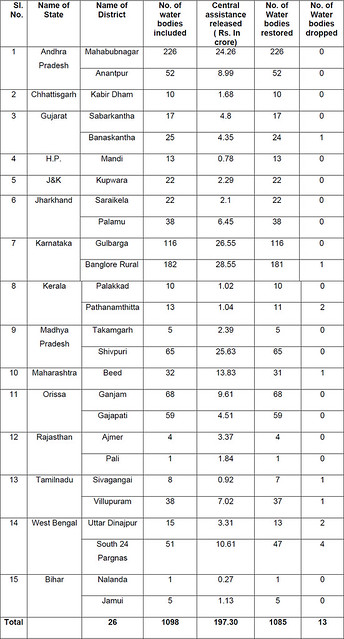
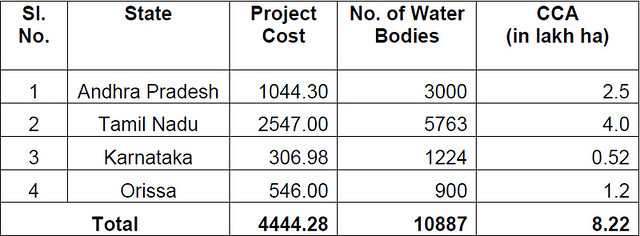 Ann.-IV
Ann.-IVDetails of World Bank assisted Projects on Repair, Renovation and Restoration ofWater Bodies
Project 1: Andhra Pradesh and Telangana State Community- Based Tank Management
Project Objectives:
The project seeks to enable selected tank based producers to improve agriculturalproductivity, and water users associations to manage tank systems effectively.Theproject will rehabilitate 2,100 tanks out of 95,000 tanks in the united Andhra Pradesh(about 45,000 in AP and 50,000 in Telangana).
In addition, the project
• primarily helps in modernizing these tank systems and improving irrigationefficiency,
• brings in agriculture technologies to improve agriculture productivity anddiversity,
• helps in establishing agri-business supply chain including fishery development,and
• undertakes extensive canal rehabilitation work
Key Project Dates:
Effectiveness Date: 27-Jul-2007
Original Closing Date: 31-Dec-2012
Revised Closing Date: 31-Jul-2016
Components:
• Institutional Strengthening:(Cost $16.40 Million)
• Minor Irrigation Systems Improvement:(Cost $150.60 Million)
• Agricultural Livelihoods Support Services:(Cost $25.20 Million)
• Project Management:(Cost $12.50 Million)

Implementation Status:
The project continues to show good progress in improving irrigation efficiency andagricultural productivity in the Tank command areas. Consequent upon the statebifurcation, the project budget, the past expenditures (including Bank financing) andthe future expenditures to be incurred have been reallocated between Andhra Pradeshand Telangana, and the revised Project Agreement, Legal Agreement and FinancialAgreement have been signed on 5 March, 2015 and shared by the Bank with both stategovernments and Department of Economic Affairs, Government of India.
Progress Indicators
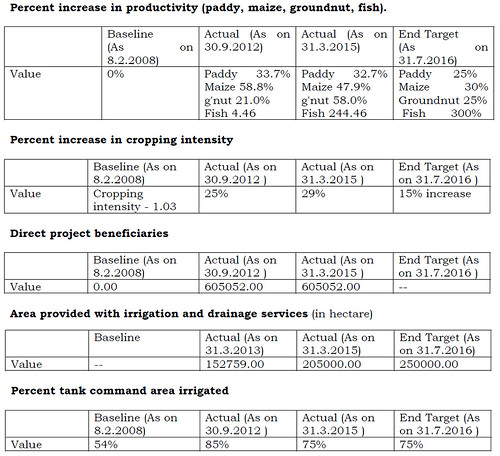 Project 2: Orissa Community Tank Management Project
Project 2: Orissa Community Tank Management ProjectProject Objectives:
The project seeks to enable selected tank based producers to improve agricultural productivity, and water user associations to manage tank systems effectively.
• The project will rehabilitate 324 tanks out of 4000 tanks in the state.
• The project has a strong livelihood component.
• Water User Groups are called Pani Panchayats, and 115 Tanks havealready been transferred to them.
• Extensive capacity building support is envisaged for Pani Panchayatmembers on operation and maintenance.
Key Project Dates
Effectiveness Date: 17-Mar-2009
Original Closing Date: 31-Aug-2014
Revised Closing Date: 30-Jun-2016
Components
Institutional Strengthening:(Cost $4.60 Million)
Tank Systems Improvements:(Cost $53.70 M)
Agricultural Livelihoods Support Services:(Cost $9.70 Million)
Project Management:(Cost $5.10 Million)

Implementation Status
Implementation progress and disbursement have increased. Disbursements is40%. All civil works contracts, covering the project target area of 60,000hectares are under implementation. Rehabilitation of 95 minor irrigationschemes has been completed.

 Project 3: Tamil Nadu Irrigation Agriculture Modernization Water-Bodies RestorationManagement Project
Project 3: Tamil Nadu Irrigation Agriculture Modernization Water-Bodies RestorationManagement Project
Project Objectives:
The project seeks to enable selected sub-basin stakeholders to increase irrigated agricultureproductivity in a sustainable water resources management framework. Under the project,rehabilitation work in 4931 tanks, 755 anicuts and 8613 km supply channels has beencompleted.
Key Project Dates
Effectiveness Date:09-Apr-2007
Original Closing Date:31-Mar-2013
Revised Closing Date:30-Jun-2015
Components
(A) Irrigation systems modernization in a sub basin framework:(Cost $282.83 M)
(B) Agricultural Intensification and Diversification:(Cost $166.23 M)
(C) Institutional Modernization for Irrigated Agriculture:(Cost $52.69 M)
(D) Project Management Support:(Cost $8.32 M)
(E) Water Resources Management:(Cost $5.00 M)

Implementation Status
The revised project implementation plan agreed to as part of the 9-month extension ofClosing Date to June 30, 2015 has largely been adhered to. Most of the civil works under the Project were completed by March 31, 2015. The work on other aspects of the Project is also going in accordance with the agreed timeframe. Utilization of outlays under Component B have reached 99.8% as of June, 2015. Estimated project savings stand at USD 32 million from the remaining loan funds. The Project has been successful in increasing yields for crops and meeting yield targets for most of them. The Project has also been successful in diversifying to high value crops away from paddy. At the same time, three consecutive years of drought have not allowed the investment in tank rehabilitation to demonstrate its effectiveness in terms of expanding area sown. This in turn has had impact on agricultural income in the sub-basins included in the Project.

 Project 4: Karnataka Community- Based Tank Management Project (Closed)(Cr. No.36350 & 36351 and Ln.No.4872)
Project 4: Karnataka Community- Based Tank Management Project (Closed)(Cr. No.36350 & 36351 and Ln.No.4872)
Project Objectives:
The project aimed to improve the rural livelihoods and reduce poverty through community based approaches for improving and managing selected tank systems. The project objectives also included improved water availability and distribution in the tank systems, exposure to improved agricultural practices and income generation activities for landless farmers.
Key Project Dates:
Effectiveness Date: 8-Jul-2002
Original Closing Date: 31-Jan-2009
Revised Closing Date: 31-Jan-2012
Project Components: The project adopted a programmatic approach to community-based tank management achieved through the following three components:
Component 1: Establishing Enabling Environment for Tank System Development.Establishing a conductive environment and institutional basis for community-based tank management; developing a decision support system for planning, operation & management; and strengthening project coordination and management at all levels.
Component 2: Strengthening Community Development. Human and institutional resource development and strengthening of local institutions; preparation and implementation of safeguard action plans and gender action plans; and assistance for each tank system developed under the project.
Component 3: Undertaking Tank System Improvements. This component includes (i) improving the operational performance of about 3925 tank systems through a menu of physical interventions identified and executed by local users and (ii) facilitating technical training and on-farm demonstrations in water management , agriculture and horticulture development, fisheries, forestry, and fodder production to help ensure that improved water storage and efficiency is translated into increased household incomes.

Main Achievements:
Self Managed and Sustainable Tank User Groups Established
• The project adopted a holistic approach to rehabilitate, operate and maintain tanks,starting with formations of Tank User Groups (TUGs) and concluding with the handingover of tanks to TUGs.
• By 2012, the project helped establishment of 3,126 TUGs and out of 3925 targettanks, 3710 tanks were covered under the project that are managed by 3126 TUGsand served about 133695 hectare command area. In 207 tanks, the progress had beennil and therefore, they had been dropped.
Benefits for Marginalized Groups:
• The project benefits included improved water availability and distribution in the tanksystems, exposure to improved agricultural practices and income generation activitiesfor landless farmers leading to improved livelihoods from targeting the poorestpopulations in the tank villages.
• The tanks covered under the project serve almost 5,81,000 households. Out of which,the marginalized group such as SC/ST groups represent 39% of TUG membership and34% in tanks committee. Female members also represent 40% of TUG membershipand committees as well.
• The project benefitted 2,13,900 tank command area farmers, 90% of them are small and marginal farmers. Average farm income, at constant 2012 prices, increased byRs.8,015 per year for an average holding size of 0.75 ha.
• Increased and improved irrigation coverage in the rehabilitated tanks resulted inintensified and diversified irrigated agriculture, generating additional farm employmentfor 8,050 persons per year.
Tank Rehabilitation and Resulting Agricultural Improvement:
• Tank rehabilitation led to improved water capture and use, leading to improvedlivelihoods in a command area under the 3710 project tanks for over 1,50,000 ha.
• A study showed that due to project activities, irrigated area increased by 20%, watervolume increased by 44%, rise in groundwater levels, extraction of ground waterincreased by 42%.
• In project tank command areas net income for farmers increased by 76% compared toa 42% for non-project tank farmers.
Increased Income From Project Activities:
• The project directly supported income generating activities, particularly for landlessand agriculture laborers. A large proportion of the allocated income generatingactivities funds were channeled through women’s Self-Help Groups(SHGs) and a largeportion were lower cast or tribal, with 99453 beneficiaries.
• The income of members of SHGs improved by 56% in comparison to 41% of nonbeneficiaries.
• Farm based income and employment generation activities generated by the projectthrough improved agriculture in the 3,710 rehabilitated tanks have sustained povertyalleviation impacts for about 1,90,000 rural poor in the villages. This accounts for17% of the population in the project villages.
• The project has also generated employment and income through rehabilitationinvestment in 3,710 project tanks, by generating estimated 3.2 million person days ofwage employment and wage income of Rs. 16,200 per year per job.
Institutional Strengthening
• The project has a marked impact on the manner in which tanks are managed. A senseof ownership has been created and local leaders have emerged from the villageCommunities.
• TUGs have become established as the Management Entity for the tank . A TalukaCommittee of Taluka level government agencies has been formed in several areas, witha view to supporting federations and TUGs.



Institutional Strengthening:(Cost $4.60 Million)
Tank Systems Improvements:(Cost $53.70 M)
Agricultural Livelihoods Support Services:(Cost $9.70 Million)
Project Management:(Cost $5.10 Million)

Implementation Status
Implementation progress and disbursement have increased. Disbursements is40%. All civil works contracts, covering the project target area of 60,000hectares are under implementation. Rehabilitation of 95 minor irrigationschemes has been completed.

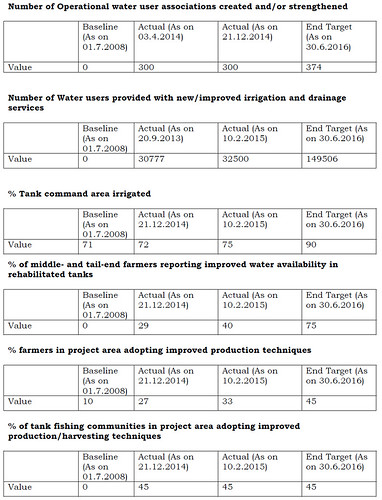 Project 3: Tamil Nadu Irrigation Agriculture Modernization Water-Bodies RestorationManagement Project
Project 3: Tamil Nadu Irrigation Agriculture Modernization Water-Bodies RestorationManagement ProjectProject Objectives:
The project seeks to enable selected sub-basin stakeholders to increase irrigated agricultureproductivity in a sustainable water resources management framework. Under the project,rehabilitation work in 4931 tanks, 755 anicuts and 8613 km supply channels has beencompleted.
Key Project Dates
Effectiveness Date:09-Apr-2007
Original Closing Date:31-Mar-2013
Revised Closing Date:30-Jun-2015
Components
(A) Irrigation systems modernization in a sub basin framework:(Cost $282.83 M)
(B) Agricultural Intensification and Diversification:(Cost $166.23 M)
(C) Institutional Modernization for Irrigated Agriculture:(Cost $52.69 M)
(D) Project Management Support:(Cost $8.32 M)
(E) Water Resources Management:(Cost $5.00 M)

Implementation Status
The revised project implementation plan agreed to as part of the 9-month extension ofClosing Date to June 30, 2015 has largely been adhered to. Most of the civil works under the Project were completed by March 31, 2015. The work on other aspects of the Project is also going in accordance with the agreed timeframe. Utilization of outlays under Component B have reached 99.8% as of June, 2015. Estimated project savings stand at USD 32 million from the remaining loan funds. The Project has been successful in increasing yields for crops and meeting yield targets for most of them. The Project has also been successful in diversifying to high value crops away from paddy. At the same time, three consecutive years of drought have not allowed the investment in tank rehabilitation to demonstrate its effectiveness in terms of expanding area sown. This in turn has had impact on agricultural income in the sub-basins included in the Project.
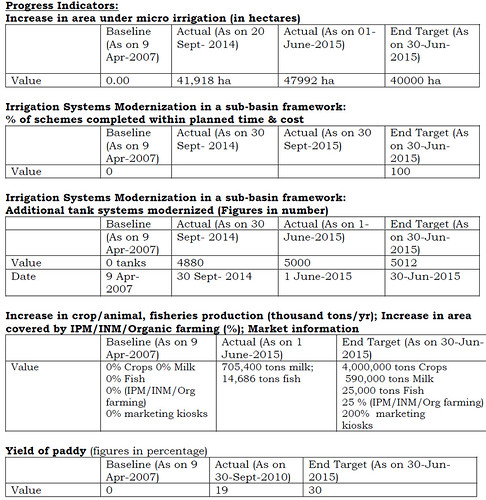
 Project 4: Karnataka Community- Based Tank Management Project (Closed)(Cr. No.36350 & 36351 and Ln.No.4872)
Project 4: Karnataka Community- Based Tank Management Project (Closed)(Cr. No.36350 & 36351 and Ln.No.4872)Project Objectives:
The project aimed to improve the rural livelihoods and reduce poverty through community based approaches for improving and managing selected tank systems. The project objectives also included improved water availability and distribution in the tank systems, exposure to improved agricultural practices and income generation activities for landless farmers.
Key Project Dates:
Effectiveness Date: 8-Jul-2002
Original Closing Date: 31-Jan-2009
Revised Closing Date: 31-Jan-2012
Project Components: The project adopted a programmatic approach to community-based tank management achieved through the following three components:
Component 1: Establishing Enabling Environment for Tank System Development.Establishing a conductive environment and institutional basis for community-based tank management; developing a decision support system for planning, operation & management; and strengthening project coordination and management at all levels.
Component 2: Strengthening Community Development. Human and institutional resource development and strengthening of local institutions; preparation and implementation of safeguard action plans and gender action plans; and assistance for each tank system developed under the project.
Component 3: Undertaking Tank System Improvements. This component includes (i) improving the operational performance of about 3925 tank systems through a menu of physical interventions identified and executed by local users and (ii) facilitating technical training and on-farm demonstrations in water management , agriculture and horticulture development, fisheries, forestry, and fodder production to help ensure that improved water storage and efficiency is translated into increased household incomes.
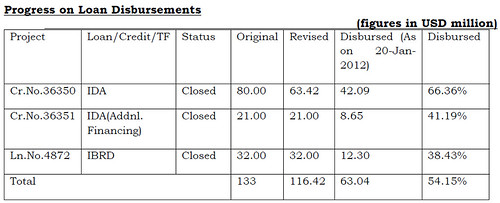
Main Achievements:
Self Managed and Sustainable Tank User Groups Established
• The project adopted a holistic approach to rehabilitate, operate and maintain tanks,starting with formations of Tank User Groups (TUGs) and concluding with the handingover of tanks to TUGs.
• By 2012, the project helped establishment of 3,126 TUGs and out of 3925 targettanks, 3710 tanks were covered under the project that are managed by 3126 TUGsand served about 133695 hectare command area. In 207 tanks, the progress had beennil and therefore, they had been dropped.
Benefits for Marginalized Groups:
• The project benefits included improved water availability and distribution in the tanksystems, exposure to improved agricultural practices and income generation activitiesfor landless farmers leading to improved livelihoods from targeting the poorestpopulations in the tank villages.
• The tanks covered under the project serve almost 5,81,000 households. Out of which,the marginalized group such as SC/ST groups represent 39% of TUG membership and34% in tanks committee. Female members also represent 40% of TUG membershipand committees as well.
• The project benefitted 2,13,900 tank command area farmers, 90% of them are small and marginal farmers. Average farm income, at constant 2012 prices, increased byRs.8,015 per year for an average holding size of 0.75 ha.
• Increased and improved irrigation coverage in the rehabilitated tanks resulted inintensified and diversified irrigated agriculture, generating additional farm employmentfor 8,050 persons per year.
Tank Rehabilitation and Resulting Agricultural Improvement:
• Tank rehabilitation led to improved water capture and use, leading to improvedlivelihoods in a command area under the 3710 project tanks for over 1,50,000 ha.
• A study showed that due to project activities, irrigated area increased by 20%, watervolume increased by 44%, rise in groundwater levels, extraction of ground waterincreased by 42%.
• In project tank command areas net income for farmers increased by 76% compared toa 42% for non-project tank farmers.
Increased Income From Project Activities:
• The project directly supported income generating activities, particularly for landlessand agriculture laborers. A large proportion of the allocated income generatingactivities funds were channeled through women’s Self-Help Groups(SHGs) and a largeportion were lower cast or tribal, with 99453 beneficiaries.
• The income of members of SHGs improved by 56% in comparison to 41% of nonbeneficiaries.
• Farm based income and employment generation activities generated by the projectthrough improved agriculture in the 3,710 rehabilitated tanks have sustained povertyalleviation impacts for about 1,90,000 rural poor in the villages. This accounts for17% of the population in the project villages.
• The project has also generated employment and income through rehabilitationinvestment in 3,710 project tanks, by generating estimated 3.2 million person days ofwage employment and wage income of Rs. 16,200 per year per job.
Institutional Strengthening
• The project has a marked impact on the manner in which tanks are managed. A senseof ownership has been created and local leaders have emerged from the villageCommunities.
• TUGs have become established as the Management Entity for the tank . A TalukaCommittee of Taluka level government agencies has been formed in several areas, witha view to supporting federations and TUGs.
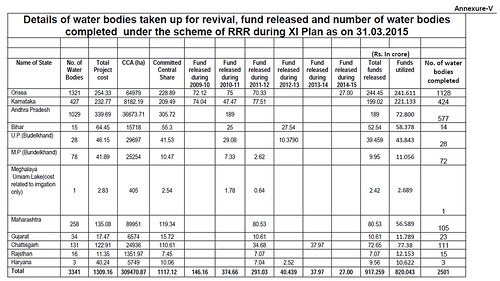


हिन्दी में पढ़ने के लिये इस लिंक को खोलें
Path Alias
/articles/background-note-repair-renovation-restoration-rrr-water-bodies
Post By: Hindi